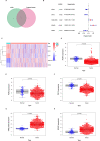Identification of a circadian gene signature that predicts overall survival in lung adenocarcinoma
- PMID: 34285836
- PMCID: PMC8272922
- DOI: 10.7717/peerj.11733
Identification of a circadian gene signature that predicts overall survival in lung adenocarcinoma
Abstract
Background: Lung adenocarcinoma (LUAD) is one of the most common subtypes of lung cancer which is the leading cause of death in cancer patients. Circadian clock disruption has been listed as a likely carcinogen. However, whether the expression of circadian genes affects overall survival (OS) in LUAD patients remains unknown. In this article, we identified a circadian gene signature to predict overall survival in LUAD.
Methods: RNA sequencing (HTSeq-FPKM) data and clinical characteristics were obtained for a cohort of LUAD patients from The Cancer Genome Atlas (TCGA). A multigene signature based on differentially expressed circadian clock-related genes was generated for the prediction of OS using Least Absolute Shrinkage and Selection Operator (LASSO)-penalized Cox regression analysis, and externally validated using the GSE72094 dataset from the GEO database.
Results: Five differentially expressed genes (DEGs) were identified to be significantly associated with OS using univariate Cox proportional regression analysis (P < 0.05). Patients classified as high risk based on these five DEGs had significantly lower OS than those classified as low risk in both the TGCA cohort and GSE72094 dataset (P < 0.001). Multivariate Cox regression analysis revealed that the five-gene-signature based risk score was an independent predictor of OS (hazard ratio > 1, P < 0.001). Receiver operating characteristic (ROC) curves confirmed its prognostic value. Gene set enrichment analysis (GSEA) showed that Kyoto Encyclopedia of Genes and Genomes (KEGG) pathways related to cell proliferation, gene damage repair, proteasomes, and immune and autoimmune diseases were significantly enriched.
Conclusion: A novel circadian gene signature for OS in LUAD was found to be predictive in both the derivation and validation cohorts. Targeting circadian genes is a potential therapeutic option in LUAD.
Keywords: Circadian clock; Gene signature; Lung adenocarcinoma; Overall survival; TCGA.
©2021 Gao et al.
Conflict of interest statement
The authors declare there are no competing interests.
Figures





Similar articles
-
Development and Validation of a Ferroptosis-Related Gene Signature for Overall Survival Prediction in Lung Adenocarcinoma.Front Cell Dev Biol. 2021 Jul 7;9:684259. doi: 10.3389/fcell.2021.684259. eCollection 2021. Front Cell Dev Biol. 2021. PMID: 34307361 Free PMC article.
-
Development and validation of endoplasmic reticulum stress-related eight-gene signature for predicting the overall survival of lung adenocarcinoma.Transl Cancer Res. 2022 Jul;11(7):1909-1924. doi: 10.21037/tcr-22-106. Transl Cancer Res. 2022. PMID: 35966313 Free PMC article.
-
A seven-gene prognostic signature predicts overall survival of patients with lung adenocarcinoma (LUAD).Cancer Cell Int. 2021 Jun 6;21(1):294. doi: 10.1186/s12935-021-01975-z. Cancer Cell Int. 2021. PMID: 34092242 Free PMC article.
-
Development and validation of a robust immune-related prognostic signature in early-stage lung adenocarcinoma.J Transl Med. 2020 Oct 7;18(1):380. doi: 10.1186/s12967-020-02545-z. J Transl Med. 2020. PMID: 33028329 Free PMC article.
-
Identification of a three-gene expression signature and construction of a prognostic nomogram predicting overall survival in lung adenocarcinoma based on TCGA and GEO databases.Transl Lung Cancer Res. 2022 Jul;11(7):1479-1496. doi: 10.21037/tlcr-22-444. Transl Lung Cancer Res. 2022. PMID: 35958325 Free PMC article.
Cited by
-
Four circadian rhythm-related genes predict incidence and prognosis in hepatocellular carcinoma.Front Oncol. 2022 Nov 10;12:937403. doi: 10.3389/fonc.2022.937403. eCollection 2022. Front Oncol. 2022. PMID: 36439444 Free PMC article.
-
ncRNAs-mediated TIMELESS overexpression in lung adenocarcinoma correlates with reduced tumor immune cell infiltration and poor prognosis.PLoS One. 2024 Jan 23;19(1):e0296829. doi: 10.1371/journal.pone.0296829. eCollection 2024. PLoS One. 2024. PMID: 38261568 Free PMC article.
References
-
- Chen J, Liu A, Lin Z, Wang B, Chai X, Chen S, Lu W, Zheng M, Cao T, Zhong M, Li R, Wu M, Lu Z, Pang W, Huang W, Xiao L, Lin D, Wang Z, Lei F, Chen X, Long W, Zheng Y, Chen Q, Zeng J, Ren D, Li J, Zhang X, Huang Y. Downregulation of the circadian rhythm regulator HLF promotes multiple-organ distant metastases in non-small cell lung cancer through PPAR/NF-κb signaling. Cancer Letters. 2020;482:56–71. doi: 10.1016/j.canlet.2020.04.007. - DOI - PubMed
LinkOut - more resources
Full Text Sources

